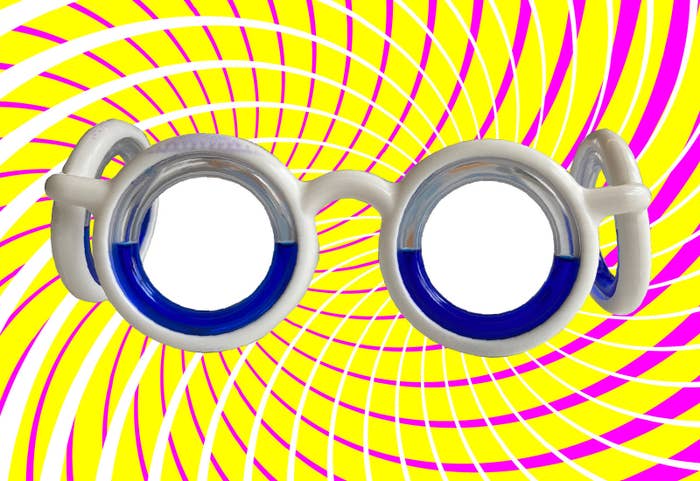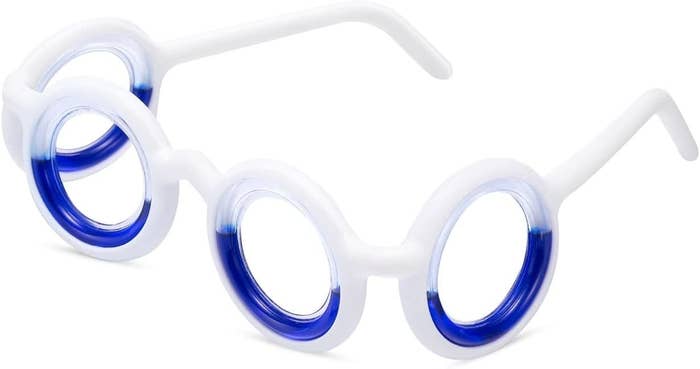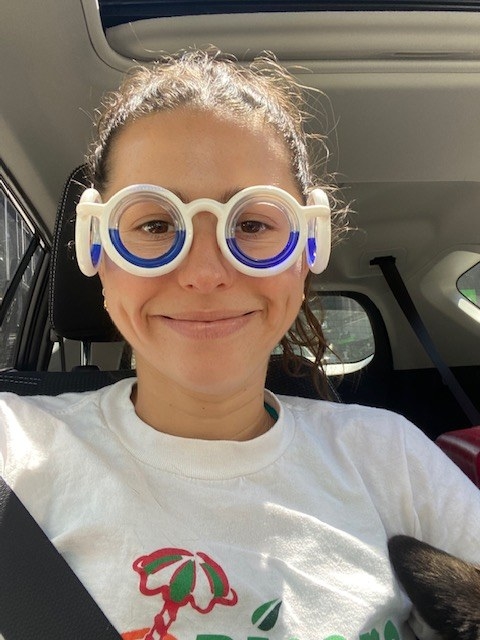
BuzzFeed may collect a share of sales or other compensation from the links on this page if you decide to shop from them. All products were independently selected by our editors, and the prices were accurate and items in stock at the time of publication.
A friend was in the backseat of my car for a long drive to the beach when she suddenly whipped out a pair of glasses that looked like a wonky, wearable science experiment. When I asked the obvious question — WHAT ARE THOSE?! — she told me that they were THE TikTok carsick glasses, as if I’d been living under a rock.

Apparently, they had been showing up on many people’s FYP on TikTok for a while. But instead of stumbling upon them while scrolling through the app with glazed eyes, I was first exposed to these glasses in real life, which was far more jarring.
Despite the fact that my friend only kept them on for about five minutes of our three and a half hour journey, I had to know more. I did my research on the Tok and concluded that the glasses seemed to have gone viral for two reasons: one, they look absurd — people love to see other people looking absurd — and two, most users were saying that they worked.
What is motion sickness?
I am unfortunately someone who gets hit hard by motion sickness any time I am a passenger in a car, on a slow-moving boat, or on a plane with the slightest bit of turbulence. It’s a lifetime affliction that has led to many arguments with my brothers after getting shoved into the backseat of our family van. (Sitting closer to the front of the car is generally better if you have motion sickness.)
God forbid I even think about glancing at my phone or a book in the car — it’s game over.
The classic symptoms of motion sickness are dizziness, cold sweats, sometimes fatigue, and headaches, often followed by nausea and vomiting (dizziness and nausea are my top two). Some studies also mention yawning, sighing, and increased salivation and burping, all of which I have also experienced and am thrilled to now have a medical explanation for.
Dr. William J. Kornrich, an internal medicine specialist at NYU Langone Medical Associates in Long Island, said that motion sickness is something he sees quite a bit with his patients.
“In this day and age where we all have phones and we’re in a car going really fast, and our body senses the car is going 55 miles per hour but we’re looking at our iPhone and the phone isn’t going anywhere, the phone is stationary, so our eyes are transmitting different information to our brain than the ears and the rest of the body,” he said. “That’s kind of the root of motion sickness — that disconnect or our brain trying to make sense of it.”
Treatments for motion sickness
It’s estimated that at least 1 in 3 people have experienced motion sickness at some point in their lives. When it comes to driving, up to 46% of passengers report some level of car sickness in the past five years.
Good first lines of defense are nonmedical remedies like acupressure bands or ginger candies and choosing your location when you travel, said Dr. Natascha Tuznik, an infectious disease specialist at the University of California, Davis.
“Location matters,” Tuznik said. “For example, if you’re on a boat, they say to avoid the upper levels. If you’re in a car, try sitting in the front. If you’re on a plane, try looking for a seat that’s over the front edge of the wing as opposed to all the way in the back.”
Some of Kornrich’s patients find relief in acupressure bands, while others prefer Dramamine, the popular over-the-counter motion sickness drug. (The generic name is dimenhydrinate.) However, Dramamine is an antihistamine, which often causes drowsiness, even with this “less drowsy” formula (I can confirm). He has also prescribed a scopolamine-containing skin patch that you can wear for up to 72 hours, but that comes with other possible side effects such as skin irritation, headaches, and dizziness.
In general, you have to be mindful about drug interactions if you go the medicinal route while taking any other medications.
Motion sickness definitely qualifies as an ailment that warrants a more effective remedy, but there are pros and cons to medical treatments. Could these carsick glasses be the magic cure? I had to find out for myself.
Testing the TikTok motion sickness glasses
Even Kornrich was intrigued by them, particularly for his patients who prefer to avoid medications. But while he thought the glasses looked cool, fashionable even, they were giving me “nerdy goblin on a road trip.”
The only redeeming physical takeaway was that they resembled the sun goggles I’m sporting in an infamous image of me as a child (pictured below), so I got some nostalgic laughs out of it.

All of this to say that if they had worked for me, I would have worn them every single time I entered a vehicle without a second thought. Nausea is one of the worst feelings I’ve ever experienced, particularly because I don’t usually vomit, so I don’t get any sense of relief. I’m forced to sit with my nausea, sometimes for hours on end, pleading with the powers that be for it to resolve itself. So if it can be avoided, making a fool of myself is a small price to pay.
The liquid in these glasses, Kornrich explained, gives you an artificial horizon that helps reset the imbalance that can cause motion sickness. It allows the eye to see a horizon that shifts with the motion of the vehicle. While they may not work for everyone, he said, there’s no risk in trying them. He would even recommend it.
Starting with wearability, I could not find a way for them to comfortably sit on my face. No matter how high or low I positioned them on the bridge of my nose, they kind of hurt. It was also sunny, and despite my best efforts, I could not keep both these motion sickness glasses and sunglasses on my face at the same time.
The instructions in the product description for my glasses told me to stare at a stationary item like a book or cellphone when I start to feel dizzy, and then wear the glasses for 10 to 14 minutes. They told me that my discomfort would be relieved in that amount of time and that the effects would continue even after taking them off.

I put them on almost immediately upon entering the car (I get queasy fast). As we scooted through the inevitable traffic of Midtown Manhattan, I found myself growing increasingly nauseous, despite the glasses. I did look at my phone here and there because traffic is boring, but I was wearing the glasses. Since they’re supposed to create an artificial horizon to orient your eyes, I thought I would be nausea-free while looking at a stationary object. I was not.
That’s really all I can say about it. While I believe the glasses may have helped some of those TikTokers, I felt little motivation to endure the discomfort given that the goofy little spheres obstructed my eyeline. Is it worth it to look like a squinting goober while still suffering from nausea? For me, personally, no.
However, just because they didn’t work for me doesn’t mean they might not be helpful for you.
“Of course, every patient is different and in some people it may work well, in other people not so well,” Kornrich said. “I don’t think there's anything dangerous about it. We encourage people to give it a try.”
If you want to test them out for yourself, you can buy these Hion Anti–Motion Sickness Glasses from Amazon for around $22.
